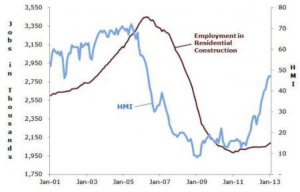The Relationship Between HMI and BLS!
 Every month, the NAHB Housing Market Index (HMI) provides an overall measure of builder confidence in the strength of the single-family housing market.
Every month, the NAHB Housing Market Index (HMI) provides an overall measure of builder confidence in the strength of the single-family housing market.
Also every month, the U.S. Bureau of Labor Statistics (BLS) produces estimates of employment in residential construction (or at least it has since 2001, when it began to split jobs in the various trades into residential and non-residential categories, a move strongly endorsed by NAHB at the time).
Previous research has shown that the HMI has ability to predict single-family housing starts out to about 6 months in the future. Now we can ask—is there any similar relationship between the HMI and the BLS measure of employment?
The answer is yes. In fact, there is a positive correlation between the HMI and future residential employment. The correlation is particularly strong (above .9) between the HMI and employment about 18 months in the future. This tendency of the HMI to move in advance of employment is fairly evident in the following

A substantial lag between a change in the HMI and employment seems reasonable, given that the HMI tends to move in advance of starts, and it usually takes awhile for a change in the starts rate to translate fully into a change in the number of homes under construction at any one time.
A simple statistical estimate based on the above data shows that a one point increase the HMI leads to an increase of about 18,700 jobs in residential construction 18 months later. But the employment effects of home building are broad-based—supporting jobs not only in construction, but also in the industries that manufacture building products, transport and sell building products, and provide broker, legal, accounting, architectural, engineering, and other professional services to builders and buyers.
NAHB research has shown that, when a home is built, the number of jobs generated in these other industries is about the same as the number of construction jobs. So, as a general rule, a one point change in the HMI leads to a change of 37,000 jobs one and a half years later—about half the jobs in construction, the other half in industries like manufacturing, trade, transportation and professional services.
View this original post on the NAHB blog, Eye on Housing.
Follow Us: Facebook – Twitter – YouTube – LinkedIn Contact Us
